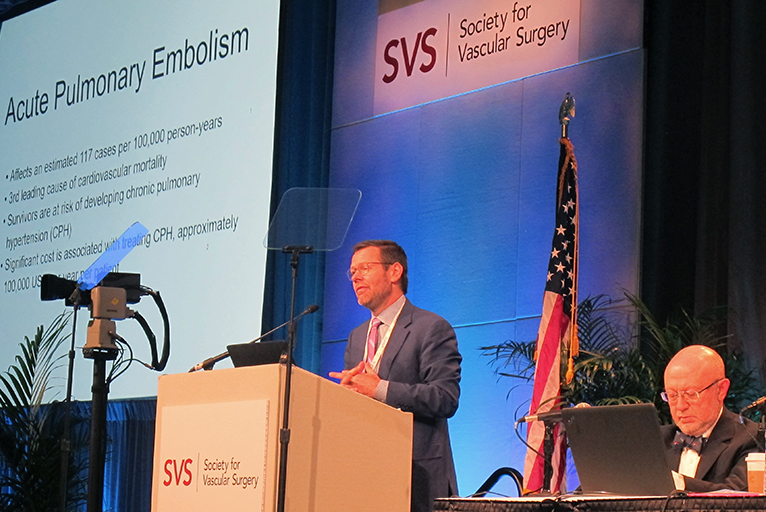
Catheter-directed thrombolysis improves outcomes and long-term cost efficiency for treatment of massive and submassive pulmonary embolism (PE), in comparison to systemic heparin administration. This was the conclusion of study investigators led by Patrick Kelly (Sanford Health, Sioux Falls, USA), who presented the results at the Society for Vascular Surgery’s Vascular Annual Meeting (SVS VAM; 12–15 June, National Harbor, USA).
“As we all know,” Kelly began, “with medicine nowadays it is not only about whether we can treat and should treat, but also whether we can afford to treat—and I think we need to start asking that question.” The study carried out by Kelly and colleagues therefore sought not only to evaluate the outcomes of treatment options available for pulmonary embolism patients, but also the overall cost-efficiency for the initially more expensive catheter-directed thrombolysis treatment to the standard systemic heparin administration.
“Acute pulmonary embolisms occur often: 177 cases per 100,000 person-years, or another way to think about that is one in every 1,000 people in your community will present with a PE in a year.” He further highlighted, it is the third leading cause of cardiovascular mortality, and patients that survive acute PE, “quite often” develop chronic pulmonary hypertension, a condition which Kelly described as “quite debilitating”. Importantly, Kelly et al note that there is a significant cost associated with treating chronic pulmonary hypertension, adding up to approximately US$100,000 per year, per patient. To investigate whether these numbers can be affected, Kelly and colleagues focused on massive and submassive PE, defined as patients who present with either systemic hypotension, cardiac arrest and/or cardiogenic shock, or right ventricular dysfunction without systemic hypotension, respectively. For this patient group, the gold standard treatment option is systemic heparin administration, while thrombolysis is reserved “for the rescue”, explained Kelly.
The retrospective, single-centre chart review study of 341 patients compared short- and long-term treatment costs for patients treated with gold standard systemic heparin administration versus patients who received catheter-directed thrombolysis. The study included 283 patients receiving catheter-directed thrombolysis, and 58 patients with systemic heparin administration. While the baseline patient characteristics were overall “pretty balanced”, Kelly pointed to a significant age difference in the two arms, with the average age of the thrombolysis being 58.83 years versus the average age of 68.47 years in the heparin arm (p=<0.001). Another “outlier” was the rate of current or recent cancer, seen in 39 thrombolysis patients (14%) versus 23 heparin patients (40%; p=<0.001).
Presenting the outcomes, Kelly outlined the positive results for the thrombolysis treatment arm, with “significantly reduced” length of stay (3.44 days vs. 6.47 days; p=<0.001). One hundred and sixty-four thrombolysis patients (58%) and 13 heparin patients (22%) had right heart strain (p=<0.001), and while not a significant difference, Kelly et al observed hypotension more often in the thrombolysis group (36 [12.7%]) than the heparin group (6 [10.3%]; p=0.616).
Thirty-day mortality was lower in the thrombolysis arm with 11 deaths (3.9%) versus 4 in the heparin arm (6.9%), “but this again did not reach significance” noted Kelly (p=0.309). However, 30-day readmission rate was significantly lower for thrombolysis patients (18 [6.4%] vs. 9 [15.5%]; p=0.019), and return to prior living conditions was seen significantly more in thrombolysis patients than in heparin patients (252 [89%] vs. 46 [79.3%]; p=0.042). Although the value of returning patients to society in healthy conditions is “difficult to measure” quantitively, Kelly emphasised the importance and even monetary benefit to society of this measurement. Finally, the statistical significance for bleeding complications was “much higher” for heparin patients, of which 8 (13.8%) suffered bleeding complications versus 12 (4.2%) in the thrombolysis group (p=0.005)—“not what we would initially expect”, Kelly said.
In the long-term cost analysis model, 100 patients from each treatment arm were analysed for initial cost to treat, rate of chronic pulmonary hypertension and cost of chronic pulmonary hypertension treatment over five years. The investigators found that while thrombolysis cost approximately an additional US$31,000 per patient to treat with catheter-directed thrombolysis versus systemic heparinisation, rate of pulmonary hypertension was observed in 6.3% of thrombolysis patients versus 15.9% of heparin patients. “Over time, expecting a five-year survival, all of a sudden catheter-directed therapy becomes much more cost effective than heparinisation therapy—actually to the point where return on investment occurs at 3.2 years,” Kelly explained. The findings of this standardised cost model suggested an “overall savings of US$1.7 million” at five years post treatment for the 100 patients in the thrombolysis arm.
In conclusion, Kelly maintained that the data suggests treatment with catheter-directed thrombolysis results in improved patient, clinical and long-term cost outcomes, when compared to systemic heparin administration, and he argued that improvements in process and device cost could further reduce the economic burden of pulmonary embolism.












